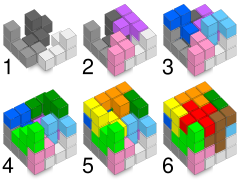


The Bedlam cube is a solid dissection puzzle invented by British puzzle expert Bruce Bedlam.
Design
The puzzle consists of thirteen polycubic pieces: twelve pentacubes and one tetracube. The objective is to assemble these pieces into a 4 x 4 x 4 cube. There are 19,186 distinct ways of doing so, up to rotations and reflections.
The Bedlam cube is one unit per side larger than the 3 x 3 x 3 Soma cube, and is much more difficult to solve.
History
Two of the BBC's 'Dragons' from Dragons' Den, Rachel Elnaugh and Theo Paphitis, were to invest in the Bedlam cube during the 2005 series. They offered £100,000 for a 30% share of equity in Bedlam Puzzles. Danny Bamping (the entrepreneur behind Bedlam cube) finally chose a bank loan instead of their investment, as seen in the relevant "Where Are They Now" episode of Dragons' Den.
Records
According to Guinness World Records, the official world record for assembling the Bedlam Cube is 11.03 seconds by Danny Bamping on 9 November 2006. The blindfolded record is 27.21 seconds by Aleksandr Iljasov on 25 February 2008.
See also
References
- Archived 2008-05-09 at the Wayback Machine: "Bruce Bedlam the Cubes inventor is putting all his royalty fees into his company 'Stonehenge Limited'"
- Bruce's Theories — Stonehenge Ltd website
- Archived 2013-03-02 at the Wayback Machine: "A review on where are they now"
- "Fastest time to assemble a Bedlam cube (Crazee Cube)". Guinness World Records. Archived from the original on 2013-12-10. Retrieved 6 December 2013.
- "Fastest time to assemble a Bedlam cube (Crazee Cube) blindfolded". Guinness World Records. Archived from the original on 2013-12-10. Retrieved 6 December 2013.
External links
- The Official Site of Bedlam Puzzles (as was, 2011: last valid archive copy)
- Bedlam Cube solver
- All 19,186 Bedlam Cube Solutions
- Bedlam Cube Demonstration Software
This applied mathematics–related article is a stub. You can help Misplaced Pages by expanding it. |